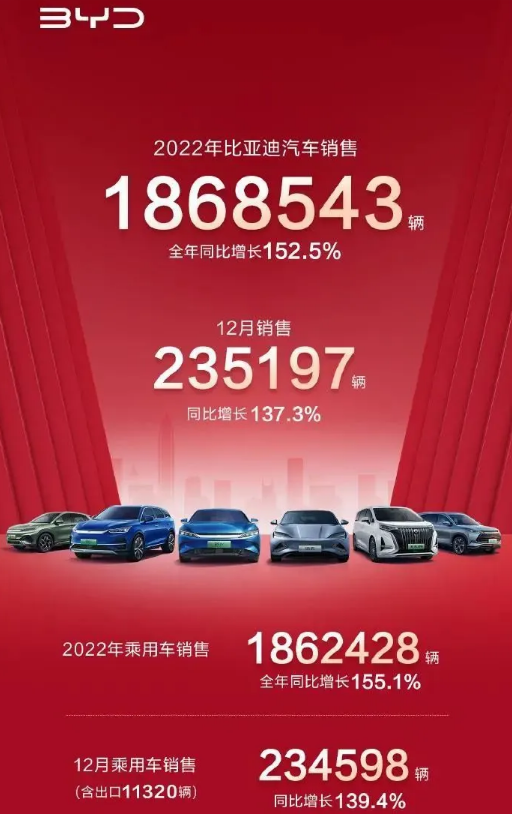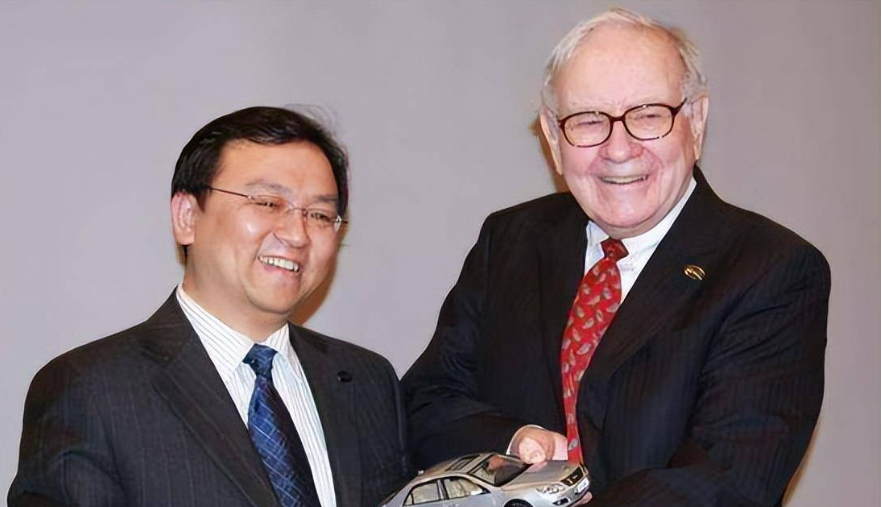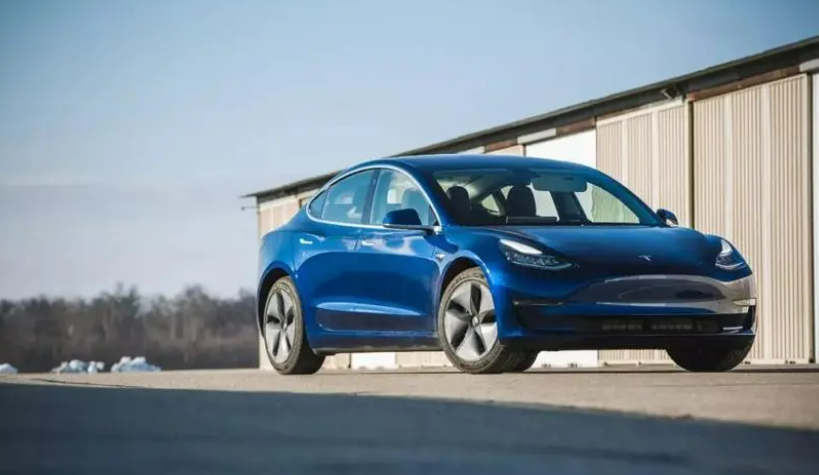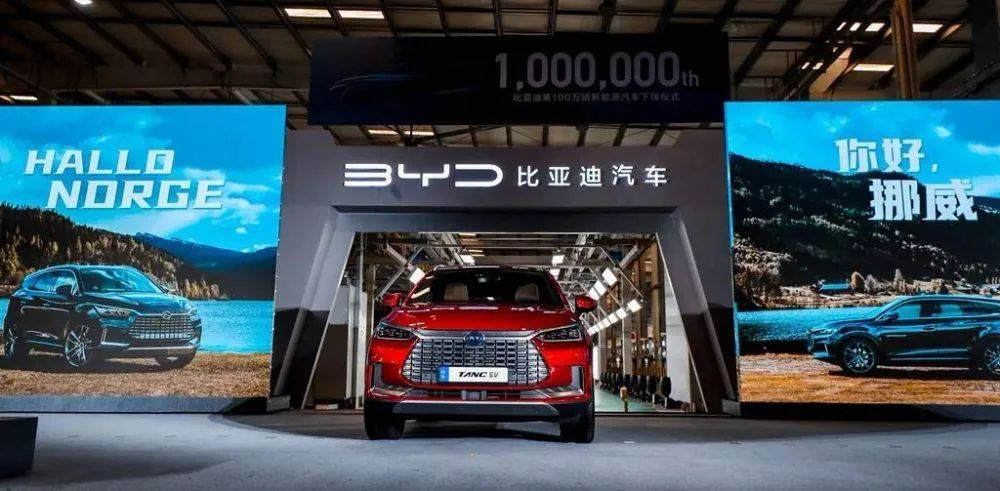Author: Dayan
Recently, BYD released its performance forecast for 2022: it is expected that BYD’s revenue in 2022 will be 420 billion yuan, with a net profit attributable to shareholders of 16-17 billion yuan, an increase of 425.42% – 458.26% year-on-year; and a non-adjusted net profit attributable to shareholders of 15.1 billion to 16.3 billion yuan, a year-on-year increase of 1103.55% to 1199.20%.

What supports such a beautiful financial report forecast is BYD’s soaring sales momentum in 2022. In 2022, the sales of BYD new energy passenger vehicles reached 1.8574 million, successfully ranking first in China’s passenger vehicle sales. Among them, the sales of pure electric vehicles were 911,100 and plug-in hybrid vehicles were 946,200. In terms of exports, BYD exported a total of 55,916 vehicles throughout the year, a year-on-year increase of 307.2%.
It is worth mentioning that in the last few months of 2022, BYD’s monthly sales were all above 200,000 units, creating a new history in China’s passenger car industry.
At the same time, on February 3, Berkshire Hathaway reduced its holdings of BYD’s stock by 1.5545 million shares. In the past six months, it has reduced its shareholdings by 35.5%. Did Buffett miscalculate by reducing his holdings of BYD?
Buffett’s reduction is still on the way
Buffett’s massive reduction is probably the only “bad news” for BYD in its unstoppable 2022 momentum.
There is no everlasting banquet. In September 2008, Buffett bought 225 million shares of BYD shares at HKD 8 per share, with a total investment of only HKD 1.8 billion, adhering to his value investment philosophy. Buffett has already earned a lot of money. Starting from August last year, Buffett has been continuously reducing his holdings of BYD. Even with BYD’s continuous sales of 200,000 units in the last four months of last year, it still did not stop Buffett’s reduction.
 According to the information disclosed by the Hong Kong Stock Exchange, Berkshire Hathaway sold another 1.5545 million shares of BYD on January 27th, with an average reduction price of HKD 226.32 per share, reducing its shareholding ratio from 13.04% to 12.9%, and cashing out HKD 350 million. Over the past six months, Buffett has reduced his holdings in BYD by more than 73 million shares, and his shareholding ratio has dropped to below 13%.
According to the information disclosed by the Hong Kong Stock Exchange, Berkshire Hathaway sold another 1.5545 million shares of BYD on January 27th, with an average reduction price of HKD 226.32 per share, reducing its shareholding ratio from 13.04% to 12.9%, and cashing out HKD 350 million. Over the past six months, Buffett has reduced his holdings in BYD by more than 73 million shares, and his shareholding ratio has dropped to below 13%.
Despite the significant rebound of the Hang Seng Index during the Spring Festival period, the rebound of BYD’s stock price from its low point has been significantly weaker than the market’s performance. According to Buffett’s current investment logic, he will continue to reduce his holdings of BYD stocks and allocate positions to companies he favors, such as traditional energy companies. After all, the impact of the Ukraine crisis will keep global oil prices hovering at high levels.
However, Buffett’s bearishness has not affected others’ optimism about BYD, including the famous UBS. According to UBS’s report, it has raised BYD’s target price in Hong Kong stocks from HKD 345 to HKD 350 and given it a “buy” rating. After all, globally speaking, BYD is the only car manufacturer that can compete with Tesla in terms of sales of electric and new energy vehicles.

Has the “Stock God” made a mistake?
From the perspective of the overall environment, the “Stock God” has not made a mistake. 2023 may be the most difficult year for various domestic new energy vehicle companies, including BYD. In January just passed, the domestic automobile market was in a slump. Although BYD’s sales still exceeded 150,000 vehicles, accounting for half of the domestic new energy automobile market, the monthly sales record of 200,000 vehicles achieved for several consecutive months at the end of last year has come to an abrupt end.

Starting from January 1st, the national subsidies for new energy vehicles have been completely withdrawn, and cities like Shanghai have cancelled their green license plate policies for hybrid models. This is not good news for BYD, which has a 1:1 sales ratio for hybrid and pure electric vehicles. Especially with the withdrawal of the national subsidy, car manufacturers with low gross profit margins will have to pass on this cost to consumers. At the end of 2022, many automakers announced price increases, including BYD. The rise in prices of new energy vehicles will inevitably affect the decisions made by consumers.From the perspective of the entire domestic new energy vehicle market, after experiencing rapid growth in the previous years, the penetration rate of our new energy vehicles has exceeded 30%. In the future, without strong policy stimulation, it is difficult for the domestic new energy vehicle market to maintain the previous rapid growth momentum. It is generally expected within the industry that the growth rate of the domestic new energy vehicle market this year will decline from the previous 100% to around 30%. Concurrent with the decline in demand growth, however, is a significant increase in supply as production lines expand and become more perfected.
Whether they are traditional joint venture giants like Toyota and GM, self-owned brand leaders such as Geely and SAIC, or newcomers like Jidu and Xiaomi, there are a large number of new energy models and brands waiting to enter the market. This means that the competition within the entire industry will become more intense.

Just as the outlook for the entire new energy market is not optimistic, the price war in 2023 has also begun at the beginning of the year. On January 6th, Tesla lowered domestic car prices for the second time in three months. Among them, the starting price of the Model 3 dropped to 229,900 yuan, and the starting price of the Model Y dropped to 259,900 yuan. While setting a new historical low price, Tesla also received a large number of orders. Even Musk claimed that the orders received by Tesla in January were twice the production capacity.
Subsequently, brands such as WM Motor and XPeng have followed suit, and it is believed that more car companies will follow in the future. For consumers, bringing competition into a price war is a very welcome development. However, for every new energy vehicle company, the reduced prices will only compress their own profit margins.
For BYD, in a market where growth is slowing in 2023, the choice between maintaining higher prices to preserve profits, or following the lead of competitors to cut prices and chase sales may be a necessary question to answer.
Under Reduction, “Dyson King” Remains Calm
Buffett has his own investment logic. Simply looking at the current stock price, even if BYD releases the most impressive financial report in history and the Hang Seng Index is also rapidly growing, BYD’s stock price remains stable. Investors value potential opportunities in the future, so Buffett’s reduction makes sense from a purely stock logical perspective.The stock market and the automotive market are related, but not completely identical. In the past few years, both the new energy vehicle market and BYD itself have experienced a period of rapid growth. When BYD took the leading position in the new energy vehicle market with an annual sales volume of 1.8574 million, it brought Buffett more than 20 times investment return. However, when the new energy concept dividend gradually released, Buffett naturally went to pursue other investment areas with higher returns, and the capital market also needs BYD to bring new stories.
Of course, BYD’s moats built in the field of three-electricity and product lines can still support it to continue to make progress in the domestic and even global new energy vehicle market. With this strong sales performance as support, there is no need to worry too much about Buffett’s reduction of holdings. After Buffett’s reduction of holdings, the stock price will decline in the short term, but with the support of the company’s good fundamentals, there will still be other investors coming in at suitable prices.
In fact, in addition to the passenger car business, BYD’s trump cards and new stories have many values that have not been fully tapped. For example, the battery business, pure electric buses, IGBT power semiconductors, energy storage equipment, etc. These areas hope to have more results to make everyone realize BYD’s hard strength beyond new energy vehicles.
Finally, today’s BYD still has room for considerable growth in the capital market. In the future, continuous investment in forward-looking areas such as vehicle intelligence, on-board chips, and next-generation energy storage technology may continuously increase BYD’s product competitiveness, and may also bring the possibility of continuous soaring in BYD’s stock price. These persistent efforts and accumulations in research and development and forward-looking technology are also building BYD’s own moats.

This article is a translation by ChatGPT of a Chinese report from 42HOW. If you have any questions about it, please email bd@42how.com.
